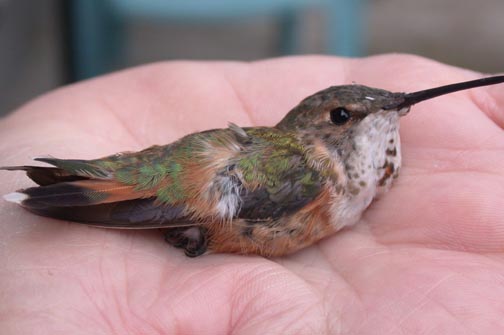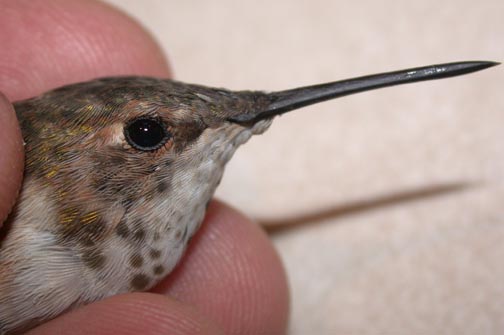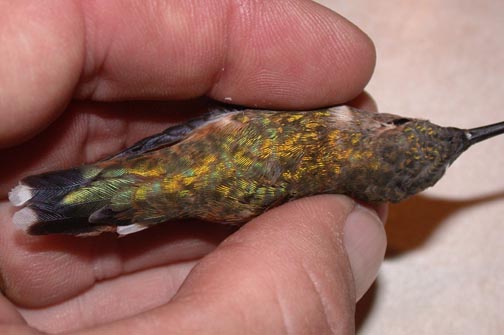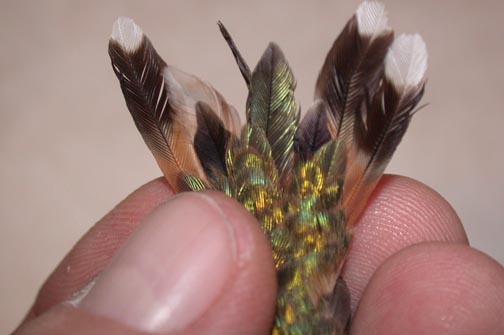|
|
Banding Data
Location Code: BER8
Click here to view description.
|
||||||||||
| Description |
Michigan Rare Bird Report Species: Rufous Hummingbird (Selasphorus rufus), immature female Date & Time: November 9, 2007. First observed by homeowner on November 5, 2007 and last observed November 11, 2007. Mike Mahler of the Sarett Nature Center confirmed the bird was not a Ruby-throat on November 8, 2007 and alerted Jon Wuepper, who alerted me. I arrived around 11:00 a.m. and waited only about 10 minutes before the bird made an appearance. I then set up my trap at 11:15 a.m. and caught the bird at 11:28 a.m. The bird was banded and released at 11:55 a.m. under Federal permit No. 23156, and Michigan permit No. SC 1303. Location: At the home of Zan and Joyce Ballard in Benton Twp., Berrien Co. Observer (s): All data and observations in this report were made by Allen Chartier. Brenda Keith, Rich Keith, Jon Wuepper, and Caleb Putnam were also present. Equipment: Photographed in-hand with digital camera (photos attached to this document). All measurements were made using digital calipers. Bill corrugations were determined by viewing through a 10x loupe, as they are impossible to accurately determine any other way. Viewing conditions: The sky was overcast and there was intermittent light rain. The bird was banded, weighed, and photographed indoors. Description: When the bird first made an appearance at the feeder, it was apparent that it was a Rufous or Allenís Hummingbird, based on peach-rufous on the flanks, and an irregular blotch of iridescent throat feathers. This observation was made with my naked eye from a distance of about 10-feet. The bird was then captured for banding, and it was aged, sexed, and identified in that order. The proper use of Stiles (1972) for banders requires that an individual Rufous/Allenís Hummingbird in-hand be correctly aged and sexed before a species determination can be made (B. Sargent and N. Newfield, pers. comm.). Age: The bird was aged as hatch-year (immature) based on the presence of shallow groovings or corrugations on about 50% of the upper mandible. This is universally recognized as the most reliable method for age determination in hummingbirds (Ortiz-Crespo, 1972). Sex: The upper tail coverts and rump were entirely green. The rufous on the base of the one central rectrix (r1) was restricted to about the basal 25%, and was completely covered by the green upper tail coverts. These characters suggested this bird was a female. The wing measurement of 44.35 mm was about 1 mm longer than any age of male Rufous or Allenís given in Stiles (1972), so this measurement is a strong indication that the bird was female. The bill measurement (exposed culmen) can sometimes be helpful for determining sex. This birdís exposed culmen measurement of 17.86 mm was longer than adult and immature males of nominate (S. s. sasin) Allenís Hummingbird, but within range for both males and females of the sedentarius subspecies* of Allenís. So, the bill measurement somewhat supports the sex as female. The pattern of iridescent gorget feathers on the throat can sometimes be helpful in determining the sex of Selasphorus hummingbirds. This bird had 6 clustered together in the center of the throat (see photos). This pattern could occur in either immature males or females, and the number of iridescent feathers varies considerably and is not particularly useful for supporting an age determination. There is a tendency for immature males and immature females to have fewer iridescent feathers, so this birdís throat pattern weakly supports it as an immature female. Species: Given that the bird was a hatch-year (immature) female, using Stiles (1972) we can determine whether this bird was a Rufous or Allenís Hummingbird using several additional measurements and observations. The presence of notching and/or emargination on the second rectrix from the center (r2) is one feature that can often be observed in the field to confirm Rufous. Both r2ís of this individual were about 40% grown in, and had emargination and notching (see photos), which is diagnostic for Rufous. Using Figure 3 in Stiles (1972), the shape most closely matched figure Bb. In case there is any question of whether a growing-in feather would represent an accurate version of a fully grown feather, one of the r2ís was collected and will be deposited at UMMZ.** In addition to assessing the shape of r2, the widths of two other tail feathers, the central rectrix (r1) and the outermost rectrix (r5) are typically measured. One of the central rectrices (r1) was full grown and the other was about 50% grown. The full grown r1 was measured as 8.29 mm. (and was collected Ė to be deposited at UMMZ**). This is slightly below the mid-range for immature female Rufous (7.8-9.5 mm) given in Stiles (1972), and above the upper end of the range for immature female of nominate (S. s. sasin) Allenís (6.9-8.2 mm). It is near the middle of the range for the sedentarius subspecies of Allenís (7.3-8.4 mm). So, the width of the central rectrix is suggestive of Rufous, but not conclusive. The outer rectrices (r5) had apparently recently been molted, as they were completely absent. So, a measurement of this important character was not possible. Tail measurements are often not very useful. Since birdís tail was in such heavy molt, the measurement of 27.5 mm should be used with extreme caution, but is above the maximum for immature females of the nominate subspecies of Allenís (Stiles gives no corresponding measurement for immature female S. s. sedentarius). So tail length may be somewhat useful in this case to support the identification as Rufous. Also, the wing measurement of 44.35 mm is above the maximum for immature females of nominate Allenís, and is near the upper extreme for immature females of the sedentarius subspecies of Allenís (42.1-45.0 mm), so weakly supports the identification as Rufous Hummingbird. Molt: There was extensive body molt evident on this bird. The outer 4 primaries (p7-p10) were old and worn; p6 was full grown but there was still a sheath around its base indicating its growth was recently completed, and the inner primaries (p1-p5) were recently replaced and contrastingly shiny black. One central rectrix (r1) was fresh and full grown while the other was about 50% grown in. Both r2s were about 40% grown in. Both r3 and r4 on both sides were present but very worn. Both r5s were absent and apparently recently molted out. Fat/Weight: The bird had a fat code of 1 (0-3 scale) and weighed 3.98 grams, slightly above average for an immature female planning to overwinter. Voice: Brief, sharp chatter when the bird was taken in-hand from the trap, and upon release. More strident than Ruby-throated gives. Similar Species: Allenís Hummingbird is the species most similar to Rufous Hummingbird. On this bird, the diagnostic shape of the second rectrix (provided the shape of a feather growing in is reliable Ė which I believe it is) provides confirmation of the identification as Rufous. The width of the central rectrix (collected and available for DNA analysis if necessary, along with 3 additional under tail coverts that the bird shed naturally during the banding process**) provides some support for the identification as Rufous. Both wing and tail measurements also provide some support for the identification. Experience: I have seen dozens of Rufous Hummingbirds in several states, banded 42 in Michigan, Ohio, Indiana, and Ontario, and handled ~35 in Louisiana in February 2003 with Nancy Newfield, and handled about a dozen in Arizona in July 2006 helping other banders. I have seen several Allenís Hummingbirds on two trips to California and once recently in Arizona, and handled 3 in Louisiana in February 2003. As a trained, licensed hummingbird bander, I am familiar with all pertinent in-hand criteria for distinguishing Rufous from Allenís Hummingbird, in addition to known field criteria for separating these species. When report was written: This report was written on November 10, 2007 based on data and photos taken during the banding process. * There are two subspecies of Allen's Hummingbird. One is the widespread and migratory nominate subspecies (Selasphorus sasin sasin) breeding from coastal northern California to coastal southern California and mainly migrating southward into Baja California, Mexico. The other is a more range-restricted and generally non-migratory subspecies (S. s. sedentarius), breeding on California's Channel Islands and the adjacent mainland (around Los Angeles). But sedentarius presents some problems, because it is intermediate between S. s. sasin and Rufous in some characters. And, while sasin has a shorter bill than Rufous, sedentarius has a longer bill! If sedentarius were entirely sedentary, this would not be an issue. But, I've been told (N. Newfield, pers. comm.) that the first specimen of Allen's Hummingbird collected in Louisiana actually fits sedentarius! So, however remote the possibility, sedentarius must also be considered. ** One tail feather (right r4) was collected as part of a stable isotope study by a researcher in Illinois, where the feather will be sent. From this, it may be possible to determine the latitude that this individual was hatched. Additional feathers were collected and will be submitted to UMMZ. These include the left r1, the right r2, and three undertail coverts shed naturally during the banding process. References consulted: None were consulted while observing the bird in the field, nor were any used to write notes in the field or to write this report. Stiles (1972) and Pyle (1997) were available during the banding of the bird. References: Ortiz-Crespo, F.I. 1972. A new method to separate immature and adult hummingbirds. Auk 89: 851-857. Pyle, P. 1997. Identification Guide to North American Birds: Stiles, F.G. 1972. Age and Sex Determination in Rufous and Allen Hummingbirds. The Condor 74: 25-32.
|
||||||||||
| Photos |  |
||||||||||
 |
|||||||||||
 |
|||||||||||
 |
|||||||||||

